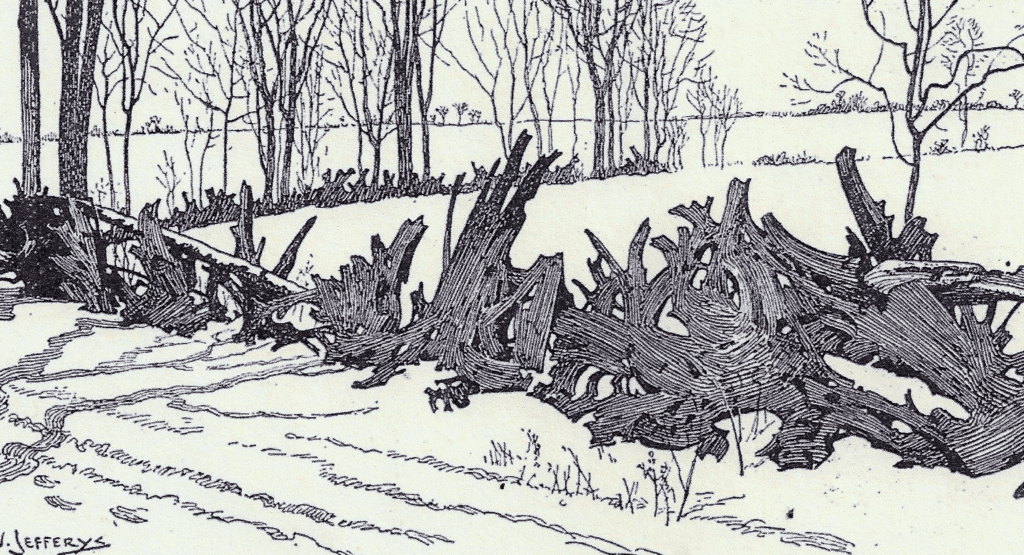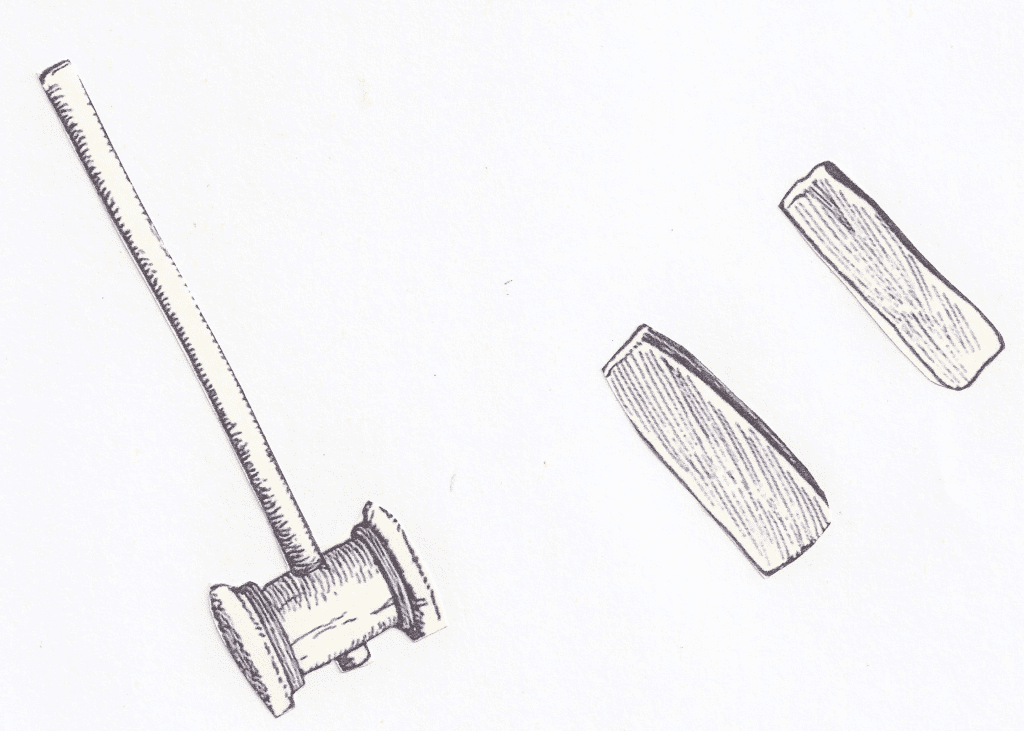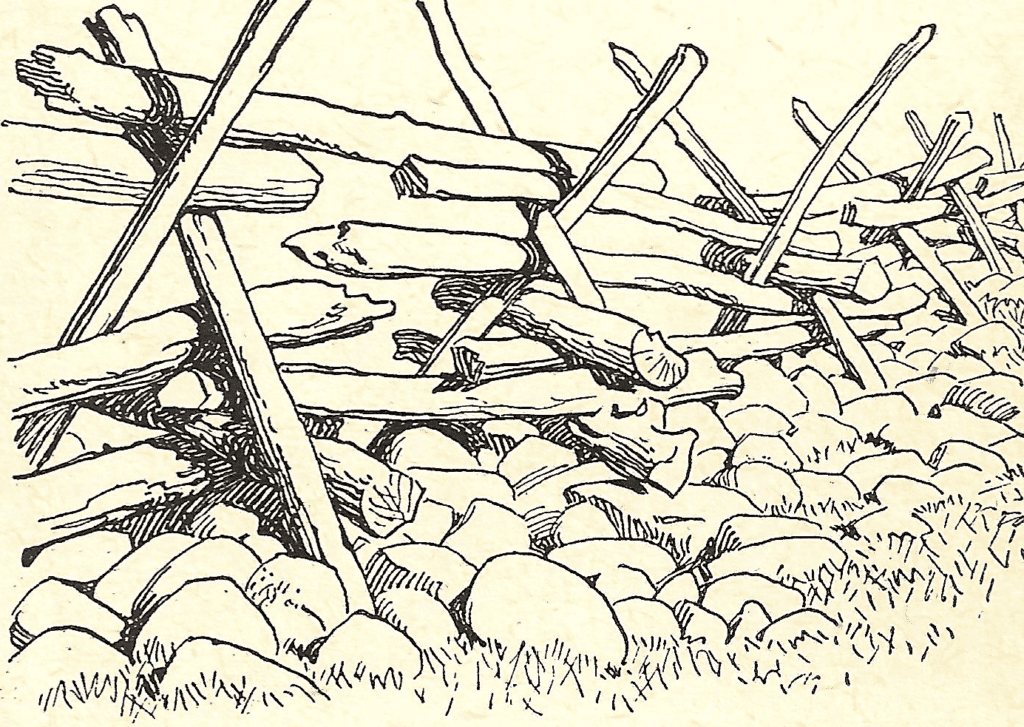Fencing

While an area was being cleared cattle, pigs and fowl were left to scrounge for themselves in tne new clearing. Salt was put out regularly to entice the pigs and cattle to return to their barn yard rather than stray too far away.
When a new field was planted a fence around it became necessary. Fencing was time consuming and the necessity to have as much land cleared as quickly as possible left little time for other work. This type of root fence solved the problem.
Rock, which were plentiful in Rawdon were another choice. The fact that no stone fences seem to have survived in Rawdon might suggest there were no experts in this task and they slowly disappeared.

Once the cedar pins, posts and bars were prepared a mallet and chisel were the only tools needed to build a rail fence.
Rail fences required more effort and were often the second fences to be made. When made of cedar they lasted many years. Rails were split from logs using a wooden mallet and metal chisels.

Cedar, a soft wood, readily available, was light and easy to work with. The pickets and posts were assembled using cedar pins.
In late fall the pickets were removed and laid on the ground to prevent damage by winter’s snow and ice. Such fences had a life expectancy of 70 or 80 years. The Coppings used cedar for rail fencing.

Various types of rail fences were built. This one used rocks from the field as well as rails.
A Consultation Regarding a Neglected Fence

The old adage, “Good fences make good neighbours” was very true.
Despite fencing, cattle and pigs, horses and oxen, frequently escape their enclosures, “getting into mischief” as George’s described it. Not being particularly respectful of line fences, animals invaded a neighbour’s tempting crop without regard to the consequences.
Certain members of the community were nominated to regulate these altercations, each party choosing a consultant to represent his cause.
George served on many “consultations” between neighbours to resolve the costs of the damage done by errant livestock.
George was also frequently one of the neighbours involved in a disputes, as well. He was not always satisfied with the settlement sometimes referring to the other party as being “very black hearted”.
Other times he severely criticized a neighbour for lack of adequate fencing and in frustration repaired the neighbour’s fence himself. A “consultation” between neighbours regarding the damage done by errant pig.
George spent many hours every spring making and repairing fences on his property. Despite his efforts, his cattle sometimes escaped, as well as the neighbours’.
His favourite ox, Lion, was forever breaking through the fence causing damage to his or a neighbour’s crop.
Pigs were another problem and George ended up fitting them with yokes. He also made yokes for the sheep.
Examples of these “consultations”:
George attended an arbitration between O’Neil and Skelly, the latter’s cows having got into O’Neil’s oat field. Petrie was present to witness for O’Neil who was awarded 5 1/2 bushels of oats in damages.
An arbitration between George and his neighbour Dowler did not go so well. George’s animals had got into Dowler’s peas and the latter demanded restitution. A consultation was called and at the end George pronounced him “very black hearted”. Mind, this did not break off communication between the neighbours as “Old Dowler” was frequently at the Copping house.
William seemed to be in a good many conflicts that were not particularly easy to settle. A dispute between William and the Laws over a kettle he bought. Mrs. Law went to see George who recorded the visit as “Mrs.Law making a noise about a sugar kettle”. The next day her husband went over to George’s threatening to take William to court if he does not settle to their satisfaction. In May there was a hearing in the village to settle the dispute. George and William as well as James and Thomas and four neighbours attended. William, George, James and Thomas. Mr. Marlin, Mr. Norris, James Norris, James Gray gathered in the village to present the case in court. No settlement was accomplished
George went over to William’s to be present at an arbitration held between William and George Keogh. A dispute about the allocation of their crops had arisen. The complaints were stated but nothing was agreed upon.
George was also frequently one of the neighbours involved in these disputes, as well. He was not always satisfied with the settlement sometimes referring to the injured party as being “very black hearted”.
Other times he severely criticized a neighbour for lack of adequate fencing and in frustration repaired the neighbour’s fence himself.
George spent many hours every year making and repairing fences on his property. Despite his efforts, his cattle sometimes escaped, as well as the neighbours’.
George’s favourite ox, Lion, was forever breaking through the fence causing damage to his or a neighbour’s crop.
Pigs were another problem and George ended up fitting them with yokes. Sheep also had yokes put on them.
George seemed to have steady cause complaint with his neighbour, Marlin, who did not keep his fence in good repair and his animals crossed into his fields.